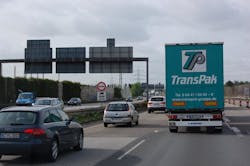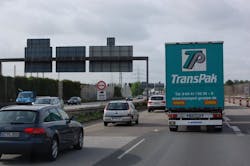I mean, just the emission control requirements for commercial trucks both here in the U.S. and in Europe (not to mention other parts of the world such as Japan) generated an enormous whirlwind of change within the transportation sector – a whirlwind that continues to spin with what seems to be no end in sight.
Yet that is only one small smidgen of the amount of change now approaching the trucking business both here and overseas – a tectonic-level order of change that may permanently reorient the nature of trucking and the myriad logistics operations it supports from here on out.
For example, check out two separate studies recently conducted by the Organization for Economic Cooperation and Development (OECD): first the group’s analysis on Trade in Value Added (TiVA) and then its Interconnected Economies: Benefitting from Global Value Chains report, which discusses the challenges and opportunities facing advanced, emerging-market and developing economies as they seek to integrate into the global marketplace.
OECD Secretary-General Angel Gurría (at right) went further at the group’s annual forum meeting at its Paris headquarters this week, pointing out that as governments become more open to trade and investment while encouraging innovation, firms can better integrate with “global value chains” or GVCs that are driving growth in increasingly interconnected economies across the world.
“Everyone can benefit from global value chains, but we will all benefit more if governments take steps to enhance the new business environment,” he said. “It is essential to embrace freer trade and resist protectionism as countries seek out new investment, faster productivity enhancement and competitiveness. Encouraging the development and participation in global value chains is the road to more jobs and sustainable growth for our economies.”
Here’s the key though: information communications technology, transportation and logistics account for over half of all value creation in the GVCs weaving through many OECD countries and over 30% in China.
Thus Gurria argues that upgrading the quality of such services, alongside trade liberalization efforts, should only furtherenhance the competitiveness of manufacturing firms – all the while making it easier for them to take part in GVCs.
“Openness to trade is also essential, as import tariffs effectively act as taxes on exports by firms that use imported components to manufacture goods for export,” he added.How might all of that impact logistics and trucking? Well Sandeep Kar (at right), global director of commercial vehicle research for consulting firm Frost & Sullivan, is going to argue in an upcoming speech that it’s going to radically alter both of those disciplines – and on a permanent basis.
“Urban logistics is already bringing about noticeable changes in commercial vehicle design, development and preferences,” he explained. “Trucks are cubing out before weighing out, telematics and connectivity are becoming more ubiquitous, time and mission critical deliveries are on the rise. Moreover, we see a world where 60% of the global population will be living in urban centers by 2025, demanding unique value propositions such as same day service.”
Kar will discuss those and other seismic shifts now taking placing in logistics and trucking in a panel presentation called Unlocking the Potential of Omni Channel Retail and Home Delivery during the North American 3PL Summit hoisted by eyefortransport June 18-20 this year.
Some of the big “mega trends” Kar believes will reshape the logistics and trucking sectors include:
- Urbanization
- So-called “Bricks and Clicks” consumer goods structures
- Access to multi-modality
- Connectivity and convergence
- Future infrastructure development focused on meeting higher demand for time-sensitive deliveries
Archana Amarnath, Frost & Sullivan’s program manager, argues that some big money is attached to those trends, too.
“Global spending on urban logistics is expected to grow rapidly from $2.5 trillion in 2011 to nearly $6 trillion by 2020 driven by B2C [business-to-consumer] ecommerce growth, rapid urbanization, and investment in sophisticated technology for better optimization,” Amarnath explained.
“This market opportunity has already attracted many logistics service providers who are introducing innovative business models in urban distribution and last mile operations such as urban consolidation centers, self-collection locker boxes, same-day deliveries, and click and collect,” he added.However, just so you know, all that doesn’t necessarily add up to a “peaches and cream” diet for logistics and transport providers, oh no.
For example, take a recent study just released by global consulting firm PricewaterhouseCoopers (PwC) on the effective tax rate or “ETR” for various industrial sectors of the global economy – including logistics and transportation.
In 2012, for example, even as logistics companies faced continued price pressures, volatile fuel prices, and the need to enhance the speed of freight routes – particularly given growing freight requirements of online sale – the average three-year ETR hit 29%; the second highest across the study group.
This “group” by the way is made up of 316 companies across a wide assortment of industries: aerospace and defense(A&D), automotive, chemicals, engineering and construction, industrial manufacturingand metals,followed by (of course) transportation and logistics.
Indeed, there’s been a steady upward trend in average ETR for industrial products and automotive companies from 2010 (26.1%) to 2012 (28.3%) despite a reduction in statutory rates of corporate income tax around the world, according to PwC.
According to PwC’s study, the increase in average three-year ETR is due in part to an improved business climate and a decrease in companies reporting losses. For example, in 2009, one in four companies in the study was in a loss making position; by 2012, the ratio was much smaller at one in 10.
Yet in terms of looking at statutory corporate tax rates by country, logistics and transportation companies here in the U.S. shouldn’t expect any breaks anytime soon.
With a combined statutory corporate tax rate of 39.1%, the U.S. had the highest corporate tax rate among advanced nations in 2012 – some 50% above the 25% average statutory corporate tax rate of other countries. While the average rate in the rest of the developed countries declined by 19 percentage points between 1988 and 2012, the U.S. rate rose slightly over this same period and one reason there’s been “heightened” engagement in assessing the direction of pending tax reform, noted Michael Burak, PwC’s U.S. and global industrial products tax leader.
“We have witnessed a steady increase in the global ETRs across the industrial products sector, as the recovery gains ground and companies continue to demonstrate improved profitability,” he said. “At the same time, we are seeing a consistently healthy level of investment spending, as companies seek to strengthen their competitive positions, while securing tax incentives that favorably impact ETRs compared to statutory rates.”
Further, with the ever-increasing globalization of commerce (a subject touched on at the start of this post) Burak argues that management teams are facing an increasingly complex tax picture, fueling interest in comprehensive tax reform.
“For multinational companies, understanding global tax policies is paramount for accessing expansion strategies and the related impact on investment returns,” he stressed.
Just goes to show, the more things change … the more complicated and difficult things get. Dang!




